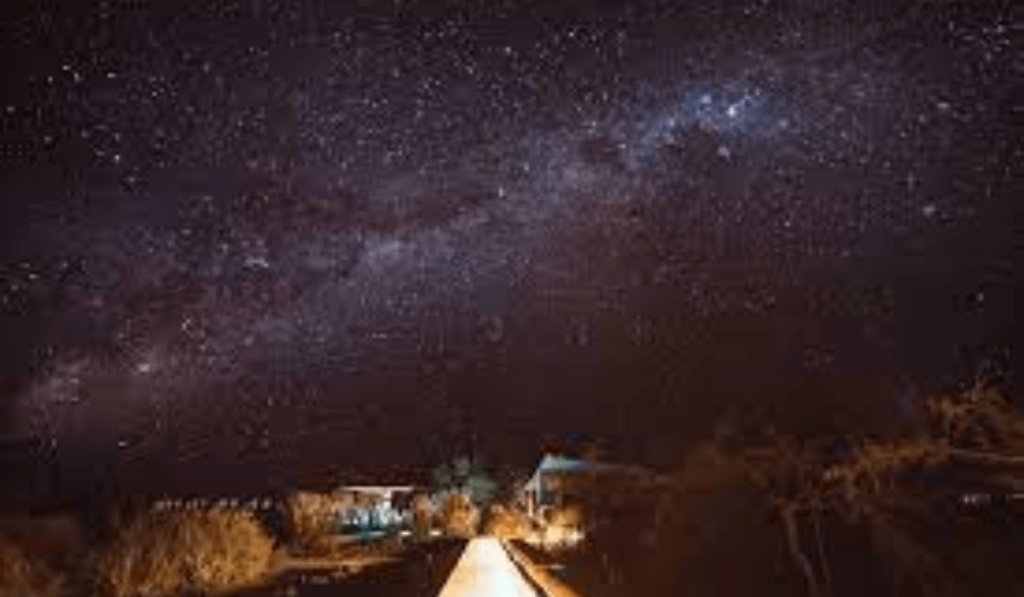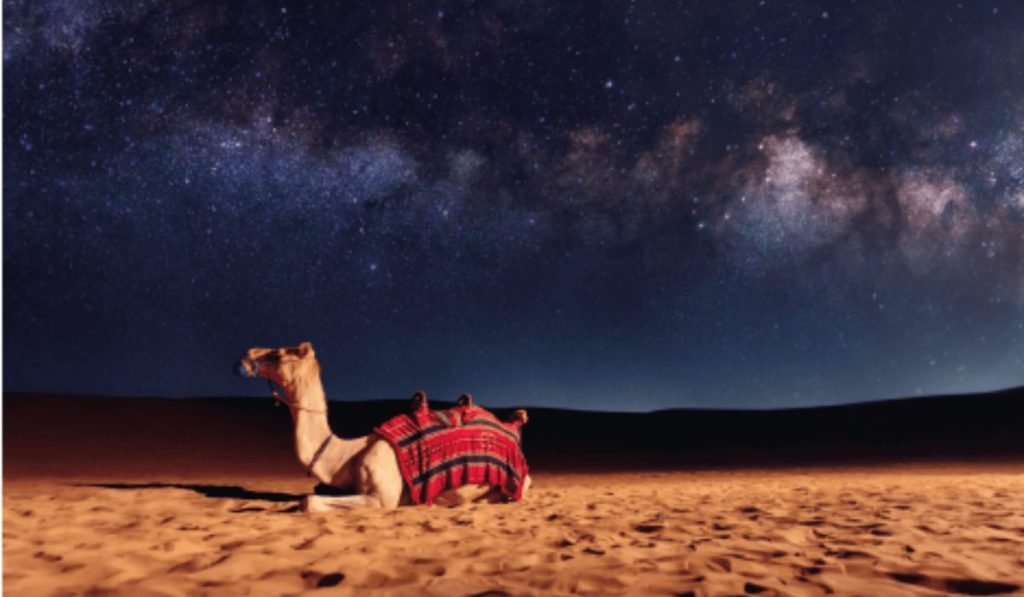Dubai, renowned for its stunning architectural marvels and vibrant cityscape, offers more than just a bustling metropolis. Beyond the city’s boundaries lies a captivating desert expanse, providing a unique opportunity for stargazing enthusiasts. In this article, we will delve into the best time to witness the celestial wonders during a desert safari in Dubai.
Understanding the Night Sky in Dubai
Dubai’s geographical location, nestled in the Arabian Desert, contributes to its clear and expansive skies, making it an ideal destination for stargazing. The absence of city lights and the vastness of the desert horizon create optimal conditions for observing celestial objects.

Dubai’s night sky is adorned with a myriad of celestial wonders, including stars, planets, and constellations. Among the prominent constellations visible from the desert are Orion, Canis Major, Taurus, and Cygnus. Gazing at these formations invokes a sense of awe and connects us with the vastness of the universe.
Factors Influencing Stargazing in Dubai
While Dubai offers favorable conditions for stargazing, several factors can impact the visibility of celestial objects. Light pollution, a common concern in urban areas, can diminish the clarity of the night sky. However, in the desert, the absence of bright city lights allows for a clearer view of the stars.
Weather conditions also play a crucial role in stargazing experiences. Clear, cloudless nights provide optimal visibility, while hazy or overcast skies may hinder observations. Monitoring weather forecasts and choosing a night with clear skies enhances the chances of a rewarding stargazing adventure.
Additionally, moon phases influence stargazing opportunities. During a full moon, the moon’s brightness can overpower faint stars and make it more challenging to observe celestial objects. Conversely, during a new moon phase, the absence of moonlight creates darker skies, perfect for stargazing.
Ideal Time of Year for Stargazing in Dubai
Dubai experiences a desert climate, characterized by hot summers and mild winters. To make the most of stargazing, it is important to consider the seasons and their impact on the night sky.
The cooler months of winter, from November to March, provide optimal conditions for stargazing in Dubai. The temperatures are more pleasant, ranging from comfortable evenings to pleasantly cool nights. During this time, the humidity is lower, reducing atmospheric haze and creating clearer skies.
Within this winter window, some months offer exceptional stargazing opportunities. December and January, in particular, tend to have clearer skies and longer nights, providing ample time for stargazing and exploration of the celestial wonders.
Best Time of Night for Stargazing in Dubai
While the entire night offers stargazing possibilities, certain hours provide the most optimal viewing experiences. It is important to understand the concept of astronomical twilight, which occurs before sunrise and after sunset when the sun is 18 degrees below the horizon. During this time, the sky is still illuminated, but stars become visible as the night deepens.

For the best stargazing experience, it is recommended to venture out into the desert after sunset and continue observing through the late evening and into the early hours of the morning. The period just after sunset allows for a beautiful transition from daylight to darkness, revealing the gradual emergence of stars and constellations.
The hours around midnight to the early morning, when the moon has set or is not yet risen, offer the darkest skies and optimal conditions for observing fainter stars, galaxies, and other celestial phenomena. During this time, the absence of moonlight allows for enhanced visibility of stars, making it an ideal time for stargazing enthusiasts to immerse themselves in the splendor of the night sky.
Desert Safari: A Unique Stargazing Experience
A desert safari in Dubai is not only an adventure into the stunning desert landscapes but also an opportunity to witness the captivating beauty of the night sky. Desert safaris combine the thrill of dune bashing, camel rides, and cultural experiences with the tranquility and magic of stargazing.
These safaris typically involve guided tours, allowing you to explore the desert with experienced professionals who are knowledgeable about the night sky. They can provide valuable insights into the celestial objects and help you navigate the vastness of the desert sky.
Planning Your Desert Safari Stargazing Experience
To ensure a memorable desert safari stargazing experience, proper planning is essential. Start by selecting a reputable desert safari tour operator that offers stargazing as part of their itinerary. Look for operators who prioritize dark sky preservation and minimize light pollution during their excursions.
When preparing for your desert safari, consider the weather conditions and pack appropriate clothing. While desert temperatures can be scorching during the day, nights can get surprisingly cool, so dress in layers to stay comfortable.
It’s also advisable to bring essentials such as a hat, sunglasses, sunscreen, and insect repellent. Don’t forget to pack a sturdy pair of shoes suitable for desert terrain, as you may be walking on sand or rocky surfaces during stargazing activities.
Essential Stargazing Equipment for Desert Safaris
While stargazing can be enjoyed with the naked eye, using certain equipment can enhance the experience, especially in the desert environment. If you’re a beginner, a pair of binoculars can provide a closer look at celestial objects such as the moon, planets, and even brighter star clusters.
For more dedicated stargazers, investing in a telescope can open up a whole new world of celestial exploration. There are telescopes available for different levels of expertise, from beginner-friendly models to advanced options for experienced astronomers. Research and choose a telescope that suits your needs and budget, keeping in mind the portability required for desert safaris.
Consider additional accessories like star charts, guidebooks, and smartphone apps to assist in identifying constellations and locating celestial objects. These tools can greatly enhance your understanding and appreciation of the night sky.
Stargazing Tips and Techniques for Desert Safaris
Master the art of stargazing in the desert with useful tips and techniques. Learn how to adapt to the darkness, identify constellations, and spot prominent celestial objects, enhancing your understanding and appreciation of the night sky.
Other Celestial Phenomena to Watch for During a Desert Safari
While stars are undoubtedly the main attraction, the desert sky offers additional celestial phenomena that can elevate your stargazing experience. Keep an eye out for meteor showers, which occur when the Earth passes through the debris left by comets or asteroids. Witnessing shooting stars streaking across the sky is a truly magical experience.
Though rare, Dubai’s desert skies occasionally treat lucky observers to sightings of the aurora borealis, also known as the Northern Lights. These ethereal displays of vibrant colors dancing across the night sky create unforgettable moments for those fortunate enough to witness them.
Capturing the Night Sky: Astrophotography in the Desert
If you’re passionate about photography, a desert safari provides an excellent opportunity to delve into astrophotography. Capturing the beauty of the night sky requires some specialized equipment and techniques.
Invest in a DSLR or mirrorless camera with manual settings that allow you to control exposure time, aperture, and ISO. Wide-angle lenses with low aperture values (f/2.8 or lower) are ideal for capturing expansive views of the night sky.
To capture the stars and celestial objects in detail, use long exposure techniques. Mount your camera on a stable tripod to prevent any movement during the long exposures, and use a remote shutter release or timer to avoid camera shake.
Experiment with different exposure times, ISO settings, and focal lengths to achieve the desired results. Additionally, consider using image stacking techniques to reduce noise and enhance the details of your astrophotographs.
Combining Stargazing with Bedouin Traditions
A desert safari offers a unique opportunity to immerse yourself in Bedouin traditions and culture. Bedouins have a deep connection with the desert and its night sky, and incorporating their traditions into your stargazing experience can add an enriching dimension to your journey.
Engage in traditional activities such as falconry, henna painting, or camel rides, allowing you to appreciate the cultural heritage of the desert. Bedouin storytelling sessions, where ancient tales are shared under the starry sky, offer a captivating insight into the deep relationship between desert-dwelling cultures and the celestial realm.
Conclusion
Embarking on a desert safari in Dubai provides an unforgettable stargazing experience. By understanding the best time to see the stars, considering the factors that influence stargazing, and following safety measures, you can maximize your chances of witnessing the celestial wonders of the desert sky. Whether you’re an amateur astronomer or a curious traveler, gazing at the stars during a desert safari is an awe-inspiring adventure that will leave you with lasting memories and a renewed appreciation for the beauty of the universe.

